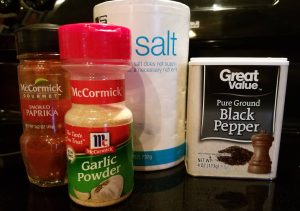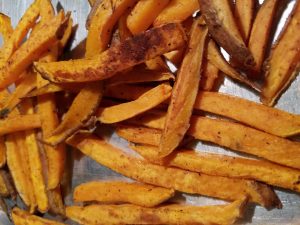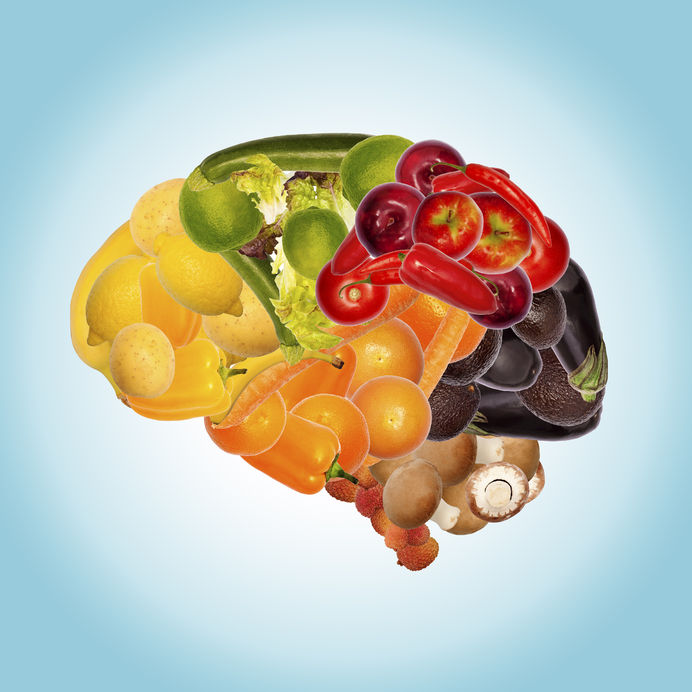Perfect Sweet Potato Fries
There are so many reasons to eat healthy, most of which we all know. However, the reality of eating healthy is sometimes inhibited by busy schedules, the need for quick go-to options, and the fear of trading taste for nutrition. Bearing that in mind, we began a series of Facebook Posts sharing what we have called “Tuck Test Kitchen” recipes. In these posts, we present our friends and followers with ideas to make their meals simpler and healthier. We have personally tried the recipes to ensure they are both easy and delicious.
For this recipe, “Perfect Sweet Potato Fries”, we wanted to share the step-by-step, in hopes that it would inspire you to give it a go. We found the original recipe for these baked fries on The Food Network website and generally followed it exactly as shown, except for extending the cooking time and reducing it in half. When we prepared this for a family of four (two adults, two young kids) and found that two large sweet potatoes resulted in a great amount. It’s easy to scale depending on the number of people you need to serve.
Ingredients:
- 5 Sweet Potatoes, washed with skin on
- Extra Virgin Olive Oil, for tossing (approximately 3-4 teaspoons)
- 1/2 Teaspoon Paprika (we love smoked paprika, if you have it!)
- 1 Teaspoon Salt
- 1/2 Teaspoon Pepper
- 1/2 Teaspoon Garlic Powder


Preheat the oven to 450°. Blend all the seasonings together in a small dish and set them aside. Next, slice the sweet potatoes (with skin on) into matchstick shapes. It is much easier to get consistent cuts if you have a mandoline slicer (just a little tip).

Once all the sweet potatoes are cut toss them with the extra virgin olive oil. Spray a baking sheet with non-stick spray and then evenly distribute the fries across the sheet. Once they are laid out sprinkle them with the seasoning mixture. The original recipe called for a baking time of 20 minutes, we found that between 30-35 minutes makes them caramelize and was more in line with our tastes. Our advice: set the time for 20 minutes, check them, and bake longer if you aren’t quite satisfied with the texture. Just a warning, when they come out you are going to want to devour them instantly. Give it a few minutes so you don’t burn your mouth! They are amazing, satisfying, and healthy–truly a winner!

Not only will you feel good about eating these because the flavor is awesome but you will feel good about them because the nutritional value is also awesome. Sweet potatoes with skin on are one of the most nutritious foods and packed with a power punch of fiber, beta-carotene, vitamin C, vitamin E, potassium, iron, and folate. Extra virgin olive oil is also a healthy source of fat because it is high in monosaturated fat which can help lower cholesterol and control insulin levels.
We hope this recipe helps you as you pursue wellness in your life, since nutrition is such a critical component. If we can partner with you further to support your wellness goals, please don’t hesitate to reach out!
About the Writer
tech
5 Types of Food That Enhance Spinal Health

Each part of the spine has a role in its mobility and integrity, and each part has specific nutritional needs.
We all face nutritional challenges. It’s hard to find time in our busy schedules to prepare fresh, healthful meals. It can be a challenge to find foods free from chemicals, and some say modern farming practices leave foods with fewer nutrients than they once had.
Yet good nutrition is essential for a healthy metabolism and for tissue growth and repair. Nutrition determines the strength of your teeth, bones, connective tissues, and your spine.
Nutrition and the Spine
The spine is an important component of the musculoskeletal system. It contains nerves as well as muscles, bones, tendons, ligaments, and discs. Each part of the spine has a role in its mobility and integrity, and each part has specific nutritional needs:
- Calcium in food plays a major role in building bone density. Weakening bones can be the result of not eating (or not absorbing) enough calcium and can lead to an increased risk of spinal fracture. Certain health conditions and bad dietary choices can lead to loss of calcium in the urine. Chronic emotional stress may lead to inflammation of the digestive tract, and consequently, prevent calcium absorption. Dairy products are a significant source of calcium, and it’s also found in leafy green vegetables, legumes, nuts, and canned fish with edible bones.
- Magnesium is as important as calcium when it comes to building strong bones: as much as 50 percent of a body’s magnesium is found in the bones. A 2013 study found that magnesium led to significant improvement in lumbar spinal range of motion in all study participants. But typical American diets include much less than the recommended daily requirement for the mineral. Alcohol use, stress, and drugs used for heart disease and high blood pressure can all cause the loss of magnesium through the urine. Magnesium is found in dark chocolate and nuts like almonds, cashews, Brazil nuts, and sunflower seeds.
- Vitamin D is essential for keeping your bones and teeth healthy. Did you know it also has an important role in immune function and cell growth? Your body needs Vitamin D in order to absorb calcium from the gut, so getting enough helps prevent bone loss and helps rebuild new bone. Vitamin D also is needed for the production of enzymes that strengthen the protein collagen, and it’s been shown to aid in the function of nerves and muscles. The shock-absorbing discs in the spine are made of collagen, and multiple studies have found that those with low levels of vitamin D are at an increased risk of developing degenerative disc disease. Eggs, anchovies, and salmon are all great sources of Vitamin D, but 20 minutes of sunlight a day is the easiest way for most people to meet the minimum daily requirement. For those with a sensitivity to UV rays, adding a vitamin D supplement to your daily regime can also provide an adequate amount of this nutrient.
- Phosphorus works along with calcium in the bones and the blood. Approximately 85 percent of the body’s phosphorus is found in the bones, where it binds with calcium to give strength and rigidity. Low intake of phosphorus can result in bone demineralization and the loss of calcium through the urine. Thus, adequate intake of both calcium and phosphorus is essential for healthy skeletal development and spine health. Phosphorus is commonly found in Brazil nuts, sunflower seeds, pumpkin seeds, and cheese.
- Healthy fats are vital for the growth and repair of normal connective tissue, bones, and body fluids. A healthy diet consisting primarily of lean proteins, healthy fats and fresh fruits and vegetables is a perfect way to build a lean body and muscles that will support the spine. The fiber and carbohydrates present in whole grains and fresh produce, and the healthy fats found in olive oil, salmon, sardines, nuts, and seeds are all important parts of good nutrition and spinal health.
Keeping Your Spine Healthy
Proper nutrition, regular exercise, and good posture are all essential to the proper maintenance and continued health of the spine.
Everyone sustains a certain amount of spinal damage over the course of a lifetime. Discs can flatten and protrude from between the bones and in time, many people experience small tears in the outer layers of these discs.
If you’re suffering from back, neck, or shoulder pain, it could be related to your spine health. Contact Tuck Chiropractic Clinic to schedule an appointment. Our experienced doctors can provide personalized care to help keep your spine healthy, and help relieve pain resulting from damage that already has occurred.
Image Copyright: nerthuz / 123RF Stock Photo
About the Writer
tech
How Healthy Eating Habits Improve School Performance

Good nutrition at school can lead to positive academic performance and healthier bones.
Child health experts in the U.S. have been exploring the effects of a child’s diet on academic performance and behavior for more than two decades. Data strongly suggest that students with better nutrition have an increased mental capacity and a lower rate of absenteeism, and generally exhibit less disruptive behavior.
Breakfast is the meal most strongly associated with doing better in school. A 2013 study found that breakfast had a positive effect on children’s academic performance, and children who regularly eat breakfast were found to be more likely to have better overall nutrition, including higher consumption of dietary fiber and lower total fat and cholesterol.
Increased Mental Capacity
Studies published in the American Journal of Clinical Nutrition, Pediatrics, and the Journal of the American Academy of Child and Adolescent Psychiatry have all concluded that hungry children have lower math scores, are more likely to repeat a grade, and come to school late. A 2012 study published in the Journal of Educational Research concluded that among participating fifth-grade students, the frequency of eating fast food and salty snacks correlated with lower math and reading scores.
Science generally supports the belief that a balanced diet can positively influence the cognitive ability and intelligence levels of school-aged children. It also favors a wider implementation and investment in school nutrition programs that can improve student access to more healthful food choices and translate into higher academic performance and overall enhanced general health.
Better Attendance
Good nutrition helps students arrive at school ready to learn, and because good nutrition helps children maintain good health, students who eat a balanced diet typically have fewer absences and attend class more consistently.
Research has shown that on the average:
- Students who eat school breakfast attend 1.5 more days of school per year than those who do not.
- Students who attend school more regularly are approximately 20 percent more likely to graduate from high school.
- High school graduates earn about $10,090 more per year and have a four percent higher employment rate than those who do not graduate.
Positive Behavior
According to the National Education Association (NEA), studies of school breakfast programs in Massachusetts, Maryland, Minnesota, and Rhode Island have found that students who eat breakfast at school exhibit fewer behavioral and psychological problems.
A 2008 British study found that while nutrition is vital for physical health, it is equally important for mental health, and a diet lacking in essential nutrients is detrimental to the healthy functioning of the brain. Researchers found that a deficiency of omega-3 essential fatty acids (EFAs) is associated with certain mental and behavioral disorders, including attention deficit hyperactivity disorder (ADHD), depression, dementia, dyspraxia, and an increase in impulsivity and aggressive behavior, although this association is not fully understood.
Stronger, Healthier Bones for Active Students
Healthy eating can also help with the prevention and healing of back pain. Leafy greens like kale and spinach provide calcium to build strong bones, so keeping your fridge stocked with these fresh whole foods will set your kids up for success this school year as they carry heavy backpacks and return to their favorite sports.
Also be aware of your family’s vitamin D intake. According to the National Institutes of Health, a lack of vitamin D can hinder your body from absorbing calcium and cause bones to grow brittle. Try a high-quality supplement or do more outdoor activities to keep your family active and healthy.
Vitamin A can promote bone growth, but if you’re filling your pantry with fortified cereals and certain dietary supplements, you may be consuming the less-preferred form of the vitamin known as Retinol. Too much retinol can actually break bones down, so be sure to eat a variety of dark orange veggies like sweet potatoes and carrots, along with leafy greens like mustard and turnip. These types of fresh foods provide the safer form of vitamin A (beta-carotene) and provide more nutritional content altogether.
Good Nutrition Can Lead to Positive Academic Performance
All children have the potential to achieve in school, but poor nutrition can put them at risk for missing out on this potential. Providing more healthful food choices in school and at home can help position students for a successful academic future.
Image By xixinxing / 123RF Stock Photo.
About the Writer
tech
Taking Care Of Your Ticker
February is National Heart Health month, so it’s a good time to check in and evaluate whether or not you are doing everything you can for a happy, healthy heart. According to the CDC, heart disease is the number one cause of death for the majority of Americans and uncontrolled high blood pressure is the number one cause of heart disease and stroke.
Heart Disease Risk Factors
The statistics regarding death, disability, and reduced quality of life due to various forms of cardiovascular disease (CVD) are staggering, as you can see in the Healthline infographic below:


According to the National Institutes of Health, obesity, poor diet, smoking, and inactivity can all contribute to an increased risk for CVD, leading to massive problems like stroke, heart attacks, and heart failure. Other risk factors include high blood pressure, diabetes and pre-diabetes, family history of heart disease, age, and high cholesterol.
How to Lower Your Risk for Heart Attacks, Strokes, and Other Heart-Related Health Problems
While family history, age, or a pre-existing condition like diabetes are not always possible to correct, reducing your overall risk usually only requires commitment and follow-through.
- Heart-healthy foods
Changing your diet to include more heart healthy food may be as simple as trading out one regular meal a week for something lighter, like having fish and vegetables instead of spaghetti and garlic bread. Arteries that have plaque build-ups (which reduce blood flow and can increase blood pressure) can be instigated or worsened by diets high in saturated and trans fats, so it might be worth it to go through the pantry and toss the regular offenders that are tempting you to sabotage a heart healthy lifestyle. Prepackaged snack foods like cakes, crackers, cookies, pies, and frostings are often full of unhealthy fats. That doesn’t mean you can’t ever eat these things, but keeping them in the house regularly probably isn’t a good plan. Instead, be sure to stock healthier, unprocessed snacks, like fruit, baby carrots, hummus, trail mix that isn’t full of candy, and other natural, easy-to-grab foods that match your lifestyle needs. - Being active
Exercise and active hobbies are an important part of maintaining a healthy weight. Because obesity is a very significant risk factor for heart disease, building time into your schedule to do aerobic and anaerobic activity 3-5 times weekly (aiming for 30-45 minutes of continuous activity) can make a significant difference. If you have struggled with maintaining a healthy weight, it is best to start more slowly, for example, walking for 20-40 minutes 3-5 times per week. Make it quality time by going with your partner, children, or pet or by calling a friend while you walk. Exercising with others is a great form of accountability and can make the process more fun as well. - Stress less
Stress can be a major trigger point for heart attacks according to the National Heart, Lung and Blood Institute. Oftentimes we have learned habits that cause us to rely on stress as a way of life, either for getting things done, relating to our family and friends or as a response to feeling like we don’t have control of our circumstances. There are several ways of breaking this habit, however, and replacing it with more healthy ways of thinking and relating to others. A few ideas for managing stress include having a few counseling sessions with your spouse or family focused on healthy, proactive communication; staying connected to your religious community through regular attendance at weekly gatherings; meditation; deep breathing practices; and relaxing exercises like yoga or other low impact, focus-enhancing workouts.
Can Chiropractic Care Help Play a Role in Reducing the Risk for Heart Disease and High Blood Pressure Management?
When working towards the prevention of heart disease, it is important to consider your individual risk factors. Both high blood pressure and reduced autonomic nervous activity can have adverse effects on heart health. Chiropractic care has been shown in some cases to reduce blood pressure. There are scientific studies and many articles discussing chiropractic care and its potential to work in cooperation with other treatments to reduce high blood pressure. According to Wolfson Integrative Cardiology, “The heart and blood vessels are connected to the central nervous system by millions of tiny connections. One major attachment is the vagus nerve (which comes from the brain) and the autonomic nervous system (which has input into the entire body). These nerves control heart rate and blood pressure, both essential factors for heart health. And although chiropractic is not a cure for heart disease and high blood pressure, it does positively impact these nerves, so clients may experience benefits related to heart health.”
We’re Here to Help
Our doctors of chiropractic are trained to identify and expertly adjust subtle misalignments in the spinal bones that can put pressure on the nerves that connect the brain and spinal cord to major organs and systems. This release of pressure may aid in lowering blood pressure, increasing nervous system health, and helping you stay active and pain-free. If you are looking to establish a routine that promotes heart health, we’re here to help. Just give us a call and set up an appointment at any of our eleven locations, where one of our doctors would be happy to talk with you about how chiropractic might help reduce your risk for heart disease.
About the Writer
tech
How Does Excessive Weight Affect the Body?

Have you ever wondered what a few extra pounds can do to your body? You may be surprised at how damaging obesity can be.
New Year, New You
Becoming healthier and specifically losing weight are among the top New Year’s resolutions. According to a Neilsen survey, more than 69 percent of resolution-makers stated a desired to live a healthier life or lose weight in 2015. Statistics gathered by the Centers for Disease Control and Prevention show that 69 percent of Americans over the age of 20 are overweight and just over 35 percent are obese. These statistics show that losing weight may be a harder battle than many people realize.
But just what are the consequences of obesity? Even apart from its association with life-threatening conditions like diabetes, heart disease, and stroke, carrying too much extra weight can cause a lot of mechanical wear and tear on your body, possibly leading to pain and mobility issues. The following seven physical problems have been tied directly to obesity:
Osteoporosis
A 2010 study by the Radiological Society of North America found that obese individuals are far more likely to have osteoporosis than individuals whose weight is at a healthy level. The study’s authors theorized that fat cells, in addition to producing hormones, also may produce chemicals that weaken bones.
Back Pain
A study of more than 50,000 men and 120,000 women using data from the Health Professionals Follow-up Study and the Nurses’ Health Study found that individuals who are overweight are far more likely to have back pain such as chronic lower back pain, spinal injuries, and vertebral disc disease. Proper alignment of the spine is difficult with excess weight, which places stress on the spine in atypical places.
Knee Damage
Excess weight places additional pressure and weight on the knees, which are not designed to carry extreme loads. A 2006 study published in the Bone and Joint Journal found that morbidly obese individuals who underwent knee replacement were more likely to have complications and problems less than four years later than patients who were not obese.
Osteoarthritis

Osteoarthritis is a type of arthritis that causes pain and inflammation in the joints. A 2008 study published in the journal Biorheology suggested that obesity may trigger arthritis due to its status as a “low-grade systemic inflammatory disease.” Inflammation can lead to an increased risk for developing arthritis in the knees, hips, wrists, and other joints.
Spine Problems
In 2014, researchers published findings in Spine that showed that obese patients being treated surgically for spinal conditions such as lumbar spinal stenosis, degenerative spondylolisthesis (DS), and intervertebral disc herniation (IDH) had significantly poorer outcomes than individuals who were not obese.
Inflexibility
Obese people are far less likely to have flexibility in the spine and other skeletal systems, according to a 2010 study published in the Journal of NeuroEngineering and Rehabilitation. According to the study’s authors, the obese have a far narrower range of motion in their spines than individuals who are a healthy weight.
Poor Posture
Weight gain can affect posture, causing individuals to bend their spine and joints in unusual ways to accommodate the extra weight. Over time, excess weight can cause poor posture, including stooped shoulders, a bent spine, hips that rotate out of alignment, and a protruding belly. A 2014 study published in Obesity Surgery said that posture improves after weight loss.
Neck Pain
Excess weight is not only bad for the lower back, but it can cause strain in the upper back and neck as well. Poor posture and uneven weight distribution can cause chronic neck pain. A 2014 study published in the European Journal of Public Health found that individuals with a BMI of 25 or higher were far more likely to report chronic neck and back pain.
While losing weight continues to be a leading New Year’s resolution, you may find it easier to say “no” when you realize just how much pain obesity can cause.
If you’re experiencing aches and pains due to obesity, consider making an appointment with one of our doctors at Tuck Chiropractic Clinic. We can help reduce your pain, as well as develop a plan for a healthier lifestyle.
Image by Jean-Paul CHASSENET/123RF.
Image by designua/123RF.
About the Writer
tech
Healthy Holiday Eating

The holidays create a lot of stress and pressure for some families and individuals; when you combine that mood with the festive foods that appear this time of year, it can be a disaster in the making. In fact, studies have shown that stress can lead to greater consumption of sweet, fatty foods – not difficult to find at office Christmas parties, school holiday events, or a friend’s gift exchange. While more chocolate or a few more of Grandma’s Christmas cookies might make you feel better in the moment, eating those kinds of foods actually might actually result in other health consequences you weren’t expecting.
According to the World Health Organization, “Unhealthy diet and lack of physical activity are leading global risks to health.” Although you may not have a problem with an expanding waistline, even a person who looks healthy may be at risk for conditions like diabetes, heart disease, stroke, and others if they are not considering their food choices carefully and staying active.
Making wise food choices does not necessarily entail a strict diet or swearing off Grandma’s cookies – you can still enjoy partaking in family traditions, while having a greater awareness of how your choices will affect your health.
Quick Guide to Healthy Holiday Foods
While stress can provoke excessive or unhealthy eating, the foods you choose can also trigger stress, creating an unvirtuous circle. The Stress Management Society offers a helpful list of foods known to trigger or aggravate stress to put on your ‘naughty,’ or at least ‘not too much’ list:
- Caffeine: like tea, coffee, cocoa, and energy drinks
- Fried foods and highly processed meals, like fast food and carryout
- Butter, cheese, and other high-fat dairy products
- More than 8 ounces of meat and shellfish (daily)
- Sugar (more than 6 teaspoons daily)
- Alcohol (1 drink for women of all ages and men over 65 and 2 drinks for men under 65 per day)
- High sugar beverages, like soda, soft drinks, and chocolate drinks
- High-fat snacks, even seemingly healthy ones, like almonds, macadamias and other nuts with high saturated fat content
- Coconut oil (if used in most areas of cooking, in small amounts, this shouldn’t be a trigger)
Everything in Moderation?
“Everything in moderation” is an oft-recited mantra during the holiday season and although having a few holiday treats is a good way to prevent binging, the saying can also be used as a justification for eating things that might be better left untouched. Only you can decide which foods are a worthwhile indulgence, but we have a few tips to help you make good decisions and feel better.
- Substitute for sugar – the average healthy adult should only get 10% of their daily calories from sugar, according to the World Health Organization guidelines, which amounts to about 6 teaspoons of sugar. But before you go putting those teaspoons in your morning coffee, you should be aware that many of the common foods you eat may have hidden sugars that count towards those six. For example, a normal fruit-flavored yogurt often contains about four and a half teaspoons of sugar and a single can of Coke contains about eight teaspoons of sugar. But before you grab a diet Coke, you should know that many of the artificial sweeteners that are found in ‘lite’ products can be detrimental to health, like aspartame, sucralose, and others. These sweeteners are often chemically altered so they are not broken down by the body and can create toxic byproducts. Rather than using commercial sweeteners then, opt for less sugar in your cookies and use mashed banana or unsweetened applesauce to make up the difference.
- Share – Christmas (and the holidays, generally) is for sharing! So next time you get a craving for chocolate chip cookies or your family’s spice cake, take half the batch to your neighbors, your office, or the nice older woman at the end of your street. If you don’t have a whole cake in the house, chances are you and your family won’t be tempted to eat the whole thing.
- Making less – rather than doubling your recipe because “it’s everybody’s favorite,” make a single batch and savor it. Spreading 12 cookies over a week will reduce your intake and increase your enjoyment of each special treat.
- Last but not least, you can make healthy alternatives to popular holiday foods that are just as delicious. While it does take time to re-train taste buds that are used to extra sugar and deep-fried delicacies, taking small steps toward better health can pay huge dividends both now and in the future. We’ve included a few recipes below to help you bring some healthy holiday cheer to your next party or potluck.
Happy Holidays!
Maple Almond Butter Cookies
Prep Time: 10 min
Cook Time: 10 min
Ready in: 20 min
Yield: 20 cookies
Ingredients:
- 1/2 cup almond butter
- 1/2 cup maple syrup (use Grade B instead of Grade A for a more pronounced maple syrup)
- 3 tablespoons canola oil
- 1 teaspoon maple or almond extract
- 1 cup whole-spelt or whole wheat flour
- 1/2 teaspoon baking soda
- 1/2 teaspoon salt
- 1/2 cup chopped almonds
Directions:
- Preheat the oven to 350°F / 175°C.
- In a large bowl, mix the almond butter, maple syrup, oil and extract until well blended.
- In a separate bowl, mix together the flour, baking soda, and salt.
- Add the dry ingredients to the wet ingredients. Add the almonds and stir just until combined. Let sit for five minutes.
- Roll tablespoons of dough into balls and place on Silpat or a cookie sheet with parchment paper. Flatten to about 1/3 of an inch.
- Bake for 8-10 minutes.
- Let the cookies cool and then store in an airtight container at room temperature for up to 1 week.
Courtesy of Texanerin Baking
Mashed Cauliflower (a healthier alternative to mashed potatoes)
Servings: 4
Ingredients:
- 1 large cauliflower, cut into small pieces (about a pound)
- 3 garlic cloves, chopped
- 2 (14 ounce) cans low sodium chicken broth (or beef broth)
- 2 tablespoons chives, chopped (or green onion)
- 2 tablespoons fresh parsley(chopped)
Directions:
- Combine cauliflower, garlic, and broth in a large saucepan. If the broth does not cover the cauliflower add water to cover.
- Bring to a boil, reduce heat to medium-low and simmer until cauliflower is fork tender, about 15 minutes.
- Drain cauliflower and garlic, reserving 2 tablespoons broth.
- Hand mash, or if you’d rather transfer to a food processor and process ’til smooth, adding broth if necessary to moisten mixture.
- Season with salt and pepper; add chives and parsley and stir.
- Serve hot.
About the Writer
tech
Tips for Fall Wellness

Exercising outside can improve your mood, increase your vitamin D level, and provide a great way for the whole family to exercise together.
Fall means football, flu season, and that last stretch of pleasant weather before winter kicks in. Days are getting shorter, temperatures are getting cooler, and as the holidays approach, it’s a tempting time to slip out of exercise routines and pack on the pounds.
This guide provides helpful tips to promote health and wellness throughout the season.
Prioritize Physical Activity
Fresh, crisp air, and beautiful changing leaves can beckon you outside, but the colder weather and shortening days can become barriers to physical activity and exercise.
Take advantage of the sunlight and try exercising outside as much as possible. You’ll get a boost of disease-fighting vitamin D, known as the “sunshine vitamin,” which is harder to come by naturally as winter approaches and the days grow ever shorter. Research shows that it’s easier to focus and concentrate on activities while you’re outdoors, so you may be more likely to keep up with a fitness program if it’s taking place outside.
With after-school activities, holidays, and busy weekends, finding time to work out can be a challenge, especially if you have younger children. Try breaking up your workout into a few mini sessions throughout the day. Try taking a walk at lunch. A few minutes of stretching in the morning before leaving for work can make it easier to fit fitness in around the day’s activities.
Recruiting a friend as a workout buddy can keep you accountable to each other. A gym partner can motivate you to show up for your workout instead of putting it off. Get the whole family involved by allocating time for family fitness every day, like a walk in the park or some hoops in the driveway. Exercising with your children can motivate parents to stay fit as well as model good physical fitness for the kids. [tweet_box design=”default” float=”none”]Exercising with your children can motivate parents to stay fit as well as model good physical fitness.[/tweet_box]
Prevent Sickness
Many people feel that it is almost impossible to avoid getting sick during the autumn and winter months. Often when you do get sick, your body builds it’s immunity and becomes stronger!
It is possible to keep yourself healthier during the winter months. Here are some tips to help you keep as healthy as possible:
- Wash your hands often and cover your mouth and nose when you sneeze
- Get plenty of sleep to avoid a weakened immune system
- Eat healthful, fresh foods with vitamins and minerals to support immune health, including plenty of vitamin C
- Drink plenty of water
- Avoid emotionally or physically stressful situations
- Get plenty of rest
- If you do get sick, stay home from work or school to avoid worsening symptoms or infecting others
- Try not to share objects that can carry germs, like drinks and kitchen utensils
- Immediately discard used tissues after coughing or sneezing to avoid spreading germs
It goes without saying, if you are running a high fever for an extended period of time, are becoming dehydrated or are feeling the ‘effects’ of a serious flu episode, seek medical attention immediately.
Maintain Good Nutrition
Autumn boasts an abundance of delicious fruits and vegetables in season. Take advantage of nutritious seasonal fruits like apples, grapes, persimmons, pears, and cranberries. Leafy greens like chard, kale, mustard greens, and spinach also are at their best in the fall months. Sweet potatoes and winter squash, which are packed with beta-carotene, are available in the autumn months. They can be roasted, pureed, or mashed.
With such a variety in season, eating well as the leaves turn doesn’t have to be a chore. These seasonal fruits and veggies tend to be hearty, filling foods that can satisfy your hunger during colder weather.
While a fridge and pantry stocked with seasonal produce is a great start, fall also brings an array of eating habits to watch out for.
From tailgating at football games to the Thanksgiving table, the temptation to overeat is everywhere. You don’t have to cut out all the bad stuff entirely, but mind your portions and try eating more of the healthier foods at the spread. Try to eat half a plate of fruits and veggies and leave the other half for everything else.
On Thanksgiving, for example, eat a healthy breakfast or snack beforehand. This may seem counterintuitive, but it will actually help you fill up sooner and make better choices about what you put on your plate.
Avoid empty, liquid calories like soda and alcohol as much as possible and limit your holiday treats to gatherings. Halloween candy and sugary food gifts are common this time of year. Don’t keep seasonal cookies and candies around the house, where you’re more likely to munch on them.
Stick With It
The hardest part of staying healthy this fall is sticking to a positive routine. Keeping up with physical fitness, keeping an eye on what you eat, and getting enough sleep are all key ways to avoid packing on holiday pounds and succumbing to the next bug making the rounds.
Fall is a busy season. Make it all simpler by getting into a rhythm now. Whether it’s packing lunches or planning a workout regimen, it will be much easier to keep everything organized with a weekly routine that you and your family can stick to.
If you prioritize healthy habits, you can successfully navigate these challenges while enjoying the beautiful weather and holiday festivities.
Check out our Back to School Guide for more information on how to stay healthy during the school year.
Image Copyright: stockbroker / 123RF Stock Photo
About the Writer
tech
Which Foods Are “Cures” Or “Causes” For Triggering Your Migraines?

Certain foods can trigger headaches while other foods can help prevent them.
It’s fall! And with the changing seasons comes shifting temperatures and the resurgence of festive foods – both potential triggers for migraines and headaches. When you can’t afford downtime because there’s work to be done or the kids have soccer practice, the last thing you need is a debilitating headache causing you to lose focus. Here are a few nutritional tips for heading off these nuisances before they start.
You may have heard that certain foods can trigger migraines – that’s true, and while some people’s “cure” foods might be others’ “cause” foods, like caffeine, there are a few foods that are pretty sure to help nearly everyone prevent the onset of a migraine.
Dr. Majid Fotuhi, a neuroscientist from John’s Hopkins recommends the following nutrients for brain health and headache prevention:
Riboflavin – also known as vitamin B2 – helps improve brain energy metabolism and the brain’s muscle cells according to Dr. Fotuhi. The good news is, it’s also fairly easy to find, appearing in star foods like spinach, asparagus, mushrooms, and quinoa. If none of these are on your top ten list, throw some spinach in an omelet or a smoothie and remember how much better spinach is than a headache.
Magnesium – especially effective for women who suffer from hormonal triggers, magnesium is found in spinach (apparently an all-purpose win for headache prevention), swiss chard, sweet potatoes, bananas, millet, sunflower seeds, and sesame seeds. Due to changes in water filtration, people are often magnesium deficient without even knowing it. Dr. Fotuhi recommends getting 450mg of magnesium per day as a good goal. You can also check with your doctor to see if you need an extra boost of this mineral.
CoQ10 – or CoenzymeQ10 as it is also called – is a major source of energy and contributes to healthy blood vessels, says Dr. Fotuhi. If you suffer from tension headaches or stress triggers your migraines, upping your CoQ10 intake may help. This little nutrient is also a neutralizer of free radicals (which are often stress-induced), meaning it prevents premature cell aging. If you are in Blacksburg or Radford, you can find CoQ10 locally at the Indigo Farms Seafood truck (mackerel and tuna are good sources) as well as in eggs, broccoli, and cauliflower.
Omega-3s – The fatty acids contained in fish and some seeds are also important immune-supporting factors. These powerful little anti-inflammatories can be found in fish, especially salmon, and flaxseed (a nearly untasteable addition to your spinach smoothie).
Last but not least, water is, without a doubt, the most important nutritional preventative measure you can take. Many of the beverages that we enjoy, like coffee, tea, alcohol, soda, or other sugary drinks actually dehydrate the body. Dehydrated cells are much more prone to illnesses of all kinds, including headaches and migraines. Opt for water and sparkling water when choosing what to drink and stay away from artificial sweeteners and excessive caffeine (known migraine triggers according to Dr. Deborah Friedman, M.D., a professor of neurology and neurotherapeutics at University of Texas-Southwestern). There are also some excellent water-rich fruits that can help you stay hydrated, including strawberries, watermelon, cantaloupe, pineapple, and grapefruit.
Just as there are a few foods that are very likely to help prevent migraine onsets, there are also some pretty common triggers; several experts, including Dr. Anne MacGregor, author of “Understanding Migraines and Other Headaches,” recommend journaling your food intake and activities throughout the day if you are headache-prone to help identify those things that lower your threshold for a migraine. These men and women suggest that excess caffeine (in coffee and chocolate), monosodium glutamate (or MSG – found in some Chinese food, processed meats, some canned vegetables, gravy, soup, and dip mixes, and soy-based foods), aged meats and cheeses, beer and wine, artificial sweeteners, and some preservatives, like nitrates and nitrites (found in some deli meats, bacon, etc.) can and should be avoided if you suffer from frequent headaches and/or migraines.
While avoiding foods can be less than fun, finding healthy, nutrient-rich, seasonal recipes with preventative value can help ease the pain. As we’ve mentioned above, smoothies are an excellent way to get many of these nutrients. We’ve included links to recipes for fun fall drinks featuring spinach, flax, and fruits listed above for you to add to your daily routine.
When headaches are making life miserable, we’re here to help. Prevent migraines and headaches through these proactive nutrition tips, stress-reducing activities like yoga, stretching, daily exercise, and chiropractic care for a healthy, happy fall.
About the Writer
tech
Back-to-School Wellness Guide

To avoid back pain, choose a backpack that isn’t bigger than your child’s torso and has wide, padded straps.
From unhealthy school lunches to heavy backpacks, kids and parents face a variety of challenges to maintaining health and wellness during the school year. As summer draws to a close and classes begin, this back-to-school wellness guide can help you and your children navigate these challenges.
Lighten the Load
On the first day of school each year, kids comes home with new classmates, new teachers — and a heavier backpack. A heavy load can cause chronic back pain in children, so to avoid side-effects from weighty textbooks, encourage your children to leave their books in lockers or at home whenever possible to prevent back strain.
Talk to your child about using both straps to carry the backpack, since putting all the weight on one side can contribute to pain in the back, neck or shoulder. Remind your child to maintain proper posture while wearing their backpack: Slouching or dropping the head will increase pressure on the cervical spine.
It also is important to choose the right backpack. Pick one that is no larger than the child’s torso. It should have a padded back, and straps that are wide, padded, and adjustable. Multiple compartments can help balance the load.
Basic Precautions Can Help Prevent Illnesses
When they return to school, kids are exposed to a wide range of health hazards, such as colds, the flu, and lice. Make sure your child follows some basic principles to reduce the chance of getting sick at school:
- Avoid touching eyes, nose, and mouth (this is the primary way diseases are spread)
- Drink plenty of water
- Cover the mouth and nose while coughing and sneezing
- Wash hands with soap and water frequently throughout the day, and tuck hand sanitizer in the backpack
- Be careful not to share brushes, combs or hats, which can spread lice, an unpleasant reality in schools
While it may be tempting to send a sick child to school, it is better to wait until they have been symptom-free for 24 hours before letting them return. Teachers and other parents will appreciate your precautions to limit the spread of the sickness.
The classroom is the first place your child may notice vision problems. Be aware of any increase in difficulty completing assignments — it may be vision-related.
Prepare Lunches And Snacks Ahead
School lunches, which often are high in salt, fat, and sugar, are considered a contributing factor to increasing childhood obesity rates. While buying lunch at school is always available for busy weeks and kids in need, with a bit of preparation and planning, you can provide your children with nourishing lunches to bring to school every day of the week.
Packing healthful lunches doesn’t have to be an insurmountable task. Preparing fruits, veggies, healthy snacks, and meals ahead of time saves time and effort later, making your morning routine a breeze. Create a master list of tried-and-true favorites and the groceries needed to prepare them. Set aside an afternoon or evening once or twice a week to plan and prepare meals for the week. Try creating a meal plan and breaking down the tasks needed to fix each meal.
The same principles can be applied to keeping a stock of after-school snacks. Children often come home from school ravenous, with dinner several hours away. For busy kids, junk food provides inadequate fuel for studying or physical activity.
Resist the urge to buy junk food and prepare quick, easy snacks instead. Some easy foods to grab and go include fresh fruits and vegetables, high-fiber granola bars that are low in sugar, and protein-rich foods like hard-boiled eggs, peanut butter, and hummus.
For more ideas about healthy options that can help keep up energy and reduce stress, check out this recent blog post.
Start on the Right Foot
Properly fitting shoes can affect your child’s posture: Foot problems which typically first appear in childhood, can contribute to back pain. Check for calluses, excessively flat feet, and other concerns to ensure proper support and fit. Small children can’t always communicate if shoes fit improperly, so look for shoes with room for growth, plenty of flexibility, and breathable fabrics.
Find a Balance Between School And Physical Activity
Homework and studying are an unavoidable part of going back to school, but helping your children achieve a balance between work and physical activity gives them the freedom to be happier and healthier.
The World Health Organization recommends kids spend at least 60 minutes a day doing physical activities. In addition to the physical benefits of exercise, research suggests that regular exercise can ward off anxiety and depression in children, increase self-esteem, and improve academic performance and quality of sleep.
Your children exercise their brains all day in school and while doing homework, so exercising their bodies provides a needed balance. Make a plan to keep track of goals for completing homework and spending time on the move.
Organized sports can provide lessons in teamwork, social skills and build character traits like perseverance. But for younger children, unstructured playtime is a fast-disappearing, yet important aspect of learning and development.
Whatever form of exercise your children choose, aim for at least an hour a day of physical activity.
Refocus Your Family Routine
Returning to school is all about new beginnings and it’s a great opportunity to reintroduce structure to your family life. Summer is often a time of relaxation and recuperation from the stress of a long school year, but if the first day of school catches you unprepared you’ll be struggling to keep up with everyone’s different schedules.
Try making a master schedule and calendar, particularly if you’re juggling students in different levels of school, with different events. You’ll know at a glance if you can supervise a school field trip or make it to the soccer game.
Avoid morning chaos by handling chores like laundry and meal planning the night before. Handle homework reminders at least an hour before bedtime to avoid excuses. For children anxious about going back to school or attending for the first time, try a practice run going to school in the morning. Another trick is to adopt a school mealtime schedule. Easing unsure children into a new school routine can calm fears and make school an enjoyable experience.
We hope this guide will help you and your family stay healthy and happy as the new school year fast approaches. If you have any questions or would like more information about back-to-school health and wellness, please don’t hesitate to contact us.
Image Copyright: rimdream / 123RF Stock Photo
About the Writer
tech
Is Your Diet Contributing to Your Stress?
Comfort Foods Aren’t So Comforting in the Long Run
Stress can cause us to turn to comfort foods — and drinks. But consoling ourselves with these carbohydrates, fats, salt, and caffeine can do more than tip the scales: Eating foods that boost cholesterol and sodium levels can increase the risk of heart attack or developing diabetes.
Fatty, salty foods are not the best choice. There are healthy alternatives that actually reduce blood levels of cortisol, the stress hormone, while providing the comfort we crave during stressful periods.
Which Foods Should You Avoid?
When you consume comfort foods like chocolate or potato chips, your body reacts in ways that increase your stress. Here are a few of the most common things we reach for while stressed and how they can affect our bodies:
- Sugar and Caffeine: Sugar and caffeine can both cause a temporary boost in energy and mood, but that latte or soda will eventually cause you to crash, making your stress and anxiety worse.
- Simple Carbohydrates: Simple carbs like baked goods made with white flour provide few vitamins and can cause an eventual crash because of their sugar content. Additionally, stress already raises your blood glucose levels, so piling on more sugar increases your risk of developing diabetes.
- Trans Fat: Trans fats are found in many junk foods like popcorn with margarine, frozen pizza, coffee creamer and more. A study conducted in 2014 found that trans fat intake increased stress levels and brain inflammation, causing memory impairment.
- Lactose: Ice cream might seem comforting during a stressful time at work or school, but lactose can cause dietary distress in some people.
What Should You Eat When You’re Stressed?
If you want to stabilize your blood glucose and levels of cortisol while stressed or sleep-deprived, what should you eat for optimal performance?
Rather than consuming stress-inducing foods like the ones mentioned above, try these stress-relieving options instead:
- Leafy Green Vegetables: Vitamins and minerals in dark green vegetables — including folate, which has been linked to increased dopamine levels — can help boost your mood. Magnesium, found in veggies like Swiss chard, regulates cortisol.
- Fish: Containing omega fatty acids, fish are good for your heart and manage your adrenaline levels. They also contain choline, which boosts your memory.
- Fresh Fruits and Vegetables: Your immune system can be weakened by chronic stress. Beta-carotene, an antioxidant found in carrots, boosts your immune system. Eat oranges and other citrus fruits to get a dose of antioxidant vitamin C. Potassium-rich fruits and veggies like bananas and avocados keep your blood pressure low.
- Complex Carbohydrate Foods: High-fiber foods fill you up and may prevent overeating that often comes with sleep deprivation caused by stress. Complex carbohydrates can stimulate serotonin production in the brain, helping you to relax.
- Yogurt: While ice cream may aggravate your digestive system, yogurt contains cultures that help to regulate digestion and maintain a variety of gut flora.
It’s hard to resist ordering take-out or reaching for a pint of ice cream when stress takes over. Keeping your kitchen stocked with healthier alternatives will help you avoid comfort food that may end up worsening your stress. Stick with whole grains and fresh foods like a salad or a yogurt parfait with fruit. Remember that food is fuel and you must make a choice: weigh your body and brain down with fatty, sugary junk foods — or empower your body with healthful choices to help you through a stressful time.
Image Copyright: sumners / 123RF Stock Photo
About the Writer
tech
You may also be interested in...

How Do Chiropractic Adjustments Work?
Chiropractic care focuses on the health and alignment of the spine, recognizing its vital role in overall well-being. A central component of… Read More

6 Types of Chiropractic Adjustments and How They Work
Chiropractic care is a popular form of healthcare focused on spinal health and overall well-being. Chiropractors use a variety of techniques to… Read More

7 Researched Benefits of Chiropractic Adjustments
Chiropractic care focuses on maintaining spinal health and addressing misalignments that can cause a variety of health issues. The practice is growing… Read More

How Chiropractic Care Can Help Ease Back Pain
Most people have felt the agony and discomfort of back pain. And while chiropractors treat more than just back pain, most people… Read More

